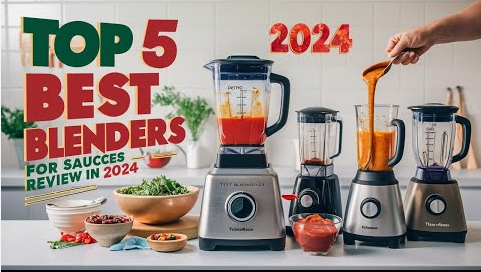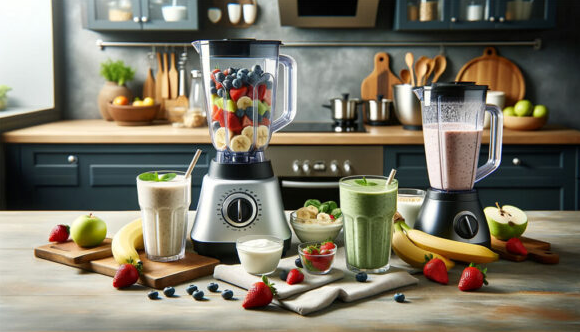Choosing between a personal vs countertop blender can be a pivotal decision for your kitchen, impacting how you prepare smoothies, soups, and more. Both types of blenders have unique strengths, making them suited for different lifestyles and culinary needs. In this comprehensive guide, we’ll compare personal and countertop blenders, focusing on the personal vs countertop blender debate to help you decide which is the best blender for you. We’ll cover blender setup, blender maintenance, blender safety, and more, ensuring you have all the information needed to make an informed choice. Let’s explore the pros, cons, and practical tips for both to find your perfect match.
What Is a Personal Blender?
A personal blender, often called a portable blender, is a compact, single-serve blender designed for quick, individual-sized blends. Typically equipped with 300–900-watt motors and 16–32-ounce cups, personal blenders are ideal for smoothies, protein shakes, and small batches of sauces. Brands like NutriBullet and Ninja Fit dominate this category, offering convenience for on-the-go users. Their small footprint makes them perfect for small kitchens or frequent travelers.
What Is a Countertop Blender?
A countertop blender is a larger, more powerful appliance designed for heavy-duty tasks and larger batches. With motors ranging from 600 to 1,800 watts and jars holding 48–72 ounces, countertop blenders excel at blending tough ingredients like ice, nuts, and fibrous vegetables. Models like the Vitamix 5200 and Blendtec Designer series are known for their versatility, handling everything from smoothies to hot soups and nut butters. They require more counter space but offer unmatched performance for frequent or family use.
For a deeper dive into blender types, check out the best blender guide at BlenderReviewz.
Personal vs Countertop Blender: Key Differences
The personal vs countertop blender decision hinges on several factors. Here’s a detailed comparison to help you weigh your options:
- Size and Capacity: Personal blenders are compact, with cups typically holding 16–32 ounces, perfect for single servings. Countertop blenders have larger jars (48–72 ounces), ideal for families or batch prep.
- Power: Personal blenders range from 300–900 watts, suitable for soft ingredients and light tasks. Countertop blenders, with 600–1,800 watts, tackle tough ingredients like ice or nuts effortlessly.
- Versatility: Personal blenders excel at smoothies and simple blends but struggle with complex tasks like nut butters. Countertop blenders handle a wide range of recipes, including hot soups and milling grains.
- Portability: Personal blenders often come with to-go cups, making them travel-friendly. Countertop blenders are stationary, requiring dedicated counter space.
- Price: Personal blenders are budget-friendly ($30–$150), while countertop blenders range from $100 to $600 for high-end models.
- Ease of Use: Personal blenders are simple, often with one-touch operation. Countertop blenders offer more controls, like variable speeds and presets, but may have a learning curve.

Top Picks for Personal Blenders in 2025
Here are some of the best personal blenders based on performance, durability, and user feedback:
1. NutriBullet Pro 900 – Best Overall Personal Blender
The NutriBullet Pro 900 is a powerhouse in the personal blender category, with a 900-watt motor and 24-ounce cups. It’s perfect for smoothies, shakes, and small batches of dips, blending frozen fruit and greens with ease.
- Key Features: 900-watt motor, two 24-ounce cups, flip-top lids, BPA-free plastic.
- Pros: Compact, powerful for its size, easy to clean.
- Cons: Not ideal for hot liquids or heavy-duty tasks like nut butter.
- Best For: Solo users or gym-goers needing quick smoothies.
2. Ninja Fit – Best Budget Personal Blender
The Ninja Fit offers a 700-watt motor and two 16-ounce cups, making it a great value at around $60. It’s ideal for basic smoothies and protein shakes, with a compact design that fits small spaces.
- Key Features: 700-watt motor, two 16-ounce cups, sip-and-seal lids.
- Pros: Affordable, portable, dishwasher-safe cups.
- Cons: Struggles with tough ingredients like seeds or ice.
- Best For: Budget-conscious users with simple blending needs.
Top Picks for Countertop Blenders in 2025
These are some of the best countertop blenders for those needing power and versatility:
1. Vitamix 5200 – Best Overall Countertop Blender
The Vitamix 5200 is a gold standard with its 1,380-watt motor and 64-ounce jar. It handles everything from smoothies to hot soups and nut butters, making it a versatile choice for serious cooks.
- Key Features: 10 variable speeds, 64-ounce jar, pulse function, tamper.
- Pros: Exceptional power, long blender motor life, versatile.
- Cons: Expensive (~$400), bulky for small kitchens.
- Best For: Families or frequent users needing durability.
2. Breville Fresh & Furious – Best Value Countertop Blender
The Breville Fresh & Furious offers a 1,100-watt motor and a 50-ounce jar at a mid-range price (~$200). It’s great for smoothies, soups, and frozen drinks, with user-friendly preset programs.
- Key Features: 5 speeds, 3 preset programs, 50-ounce jar, dishwasher-safe parts.
- Pros: Affordable, stylish, easy to clean.
- Cons: Less powerful for nut butters compared to high-end models.
- Best For: Home cooks seeking value and performance.

Blender Setup: Getting Started
Proper blender setup ensures smooth operation and blender safety. Here’s how to set up both types:
Personal Blender Setup
- Unpack and Check: Ensure all parts (base, cup, blade, lid) are included and undamaged.
- Clean First: Wash cups and blades with warm, soapy water. Dry thoroughly.
- Assemble: Attach the blade to the cup, fill with ingredients (liquids first), and secure to the base.
- Blend: Press or twist to blend, typically for 30–60 seconds. Shake if ingredients stick.
Countertop Blender Setup
- Inspect Components: Verify the base, jar, lid, and tamper (if included) are intact.
- Clean Jar: Wash the jar and lid with warm, soapy water. Avoid submerging the base.
- Secure Jar: Place the jar on the base and lock the lid for safety.
- Add Ingredients: Layer liquids, soft ingredients, then hard items like ice for optimal blending.
- Start Low: Begin at a low speed and increase gradually to protect the motor.
For more blender tips, visit BlenderReviewz.
Blender Troubleshooting: Common Issues
Both personal and countertop blenders can face issues. Here’s how to address them:
- Blender Won’t Start: Ensure proper assembly and a secure power connection. Check safety locks on countertop models.
- Uneven Blending: For personal blenders, shake the cup. For countertop blenders, use a tamper or scrape sides.
- Motor Overheating: Let the blender cool for 20–30 minutes if it shuts off. Avoid overloading with tough ingredients.
- Leaks: Check seals for wear and ensure cups or jars are not overfilled.
Blender Maintenance: Extending Blender Motor Life
Proper blender maintenance ensures longevity for both personal and countertop blenders:
- Clean Immediately: Rinse cups or jars after use. Blend warm water with a drop of soap for countertop models.
- Hand-Wash Key Parts: Avoid dishwashers for blades and seals to prevent damage.
- Inspect Regularly: Check blades for dullness and seals for wear, replacing as needed.
- Store Properly: Keep in a dry, dust-free area to protect the motor.
Blender Safety: Essential Tips
Blender safety is crucial for both types:
- Secure Lids: Lock lids or cups to prevent spills or injury.
- Avoid Hot Liquids in Personal Blenders: Most personal blenders aren’t designed for hot ingredients, unlike some countertop models.
- Unplug When Cleaning: Disconnect to avoid accidental activation.
- Follow Capacity Guidelines: Overfilling can strain the motor or cause leaks.
Personal vs Countertop Blender: Which Should You Choose?
The personal vs countertop blender choice depends on your lifestyle:
- Choose a Personal Blender If: You live alone, have a small kitchen, or primarily make single-serve smoothies or shakes. They’re budget-friendly and portable, ideal for busy individuals.
- Choose a Countertop Blender If: You cook for a family, blend large batches, or tackle complex recipes like nut butters or soups. They’re more powerful and versatile but require more space and investment.
Conclusion: Finding the Best Blender for Your Needs
In the personal vs countertop blender debate, there’s no one-size-fits-all answer. Personal blenders like the NutriBullet Pro 900 are perfect for quick, portable smoothies, while countertop blenders like the Vitamix 5200 excel in power and versatility for larger households or advanced recipes. By mastering blender setup, practicing blender safety, and following blender maintenance tips, you can ensure your blender lasts for years. For more insights and detailed reviews, explore the blender guide at BlenderReviewz to find the best blender for your kitchen. Whether you choose a personal or countertop model, happy blending!